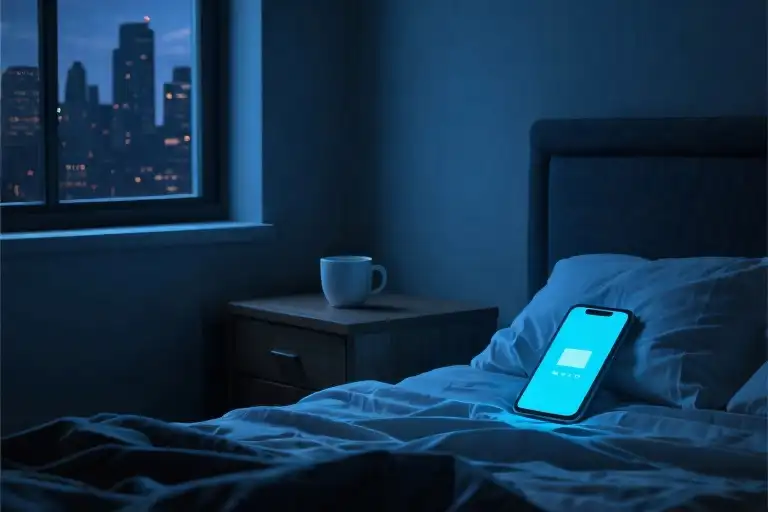The glow from my phone screen is the only light in the room now. It’s 2:37 AM according to the digital clock, that same harsh blue light illuminating my face as I scroll through conversations that ended months ago. During daylight hours, I can almost convince everyone – including myself – that I’m fine. But here in the quiet dark, the performance falls apart.
There’s something particularly cruel about nighttime heartbreak in the digital age. The same device that lets me maintain perfect composure at work by day becomes a portal to emotional ruin by night. I tap absentmindedly on the photo album icon, watching those little circles spin as old images load. A notification pops up – some app reminding me of my ‘digital wellbeing’ goals. The irony isn’t lost on me.
Research shows breakup-related insomnia peaks between 2:00 and 4:00 AM, when cortisol levels naturally rise and willpower reserves are depleted. Knowing this doesn’t make the nighttime sadness any easier, but it does make me feel slightly less alone in this ritual. Maybe you’re somewhere doing the same thing right now. Or maybe – and this thought cuts deeper – you’re sleeping soundly, having long since moved on.
The real torture isn’t in the big moments, but in the mundane digital relics: that playlist we built together still appears in my recommendations. His birthday reminder pops up annually in my calendar. The grocery app suggests recipes for two. These algorithmic ghosts haunt me more persistently than any deliberate act of remembrance could.
What fascinates me most is how our breakup has created two distinct versions of myself. Daylight Me functions with near-normal efficiency – answering emails, making small talk, even laughing at appropriate moments. But Nighttime Me? She’s a different creature entirely. She notices how the bed feels slightly too large, how the silence has a different quality without someone breathing on the other end of a late-night call. She remembers the exact cadence of his ‘goodnight’ texts.
Social media detox advice always focuses on willpower, as if resisting the urge to check old messages were simply a matter of discipline. But it’s more complicated than that. Those digital breadcrumbs aren’t just data – they’re the last tangible proof that what we had was real. Deleting them feels like erasing my own history, like admitting none of it mattered.
So here I am again, caught in this nocturnal loop. The rational part of me knows healing isn’t linear, that nighttime will always amplify emotions. But another part wonders if these lonely hours are actually serving some purpose – if maybe, by fully feeling this pain now, I’m making space for something better later. Or maybe that’s just the sleep deprivation talking.
Either way, the sun will rise in a few hours. Daylight Me will take over again, and the world will keep turning. But for now, in this blue-lit darkness, I’m letting myself miss what we had – even if, somewhere out there, you’ve already stopped missing it too.
The Daylight Masquerade
The alarm goes off at 7:03 AM – that deliberate three-minute buffer I built in to avoid facing mornings too abruptly. My fingers find the phone before my eyes open properly, swiping away notifications with the mechanical precision of someone who’s rehearsed this routine. Shower. Coffee. A strategically placed smile when colleagues ask about my weekend. The daylight hours unfold with such practiced normalcy that even I start believing the performance.
By noon, I’ve convinced three separate people that I’m ‘doing great actually.’ The script comes easily now:
- Laugh at appropriate intervals during lunch conversations
- Nod along to office gossip without absorbing a word
- Type out cheerful text responses while mentally measuring the distance between each syllable
What surprises me most isn’t how convincing the act has become, but how little energy it requires. The human capacity for autopilot could power small cities. My hands know exactly how to shape themselves around a coffee cup to suggest contentment. My voice has mastered that upward lilt signaling ‘nothing to see here.’ The real me exists somewhere behind my sternum, folded neatly like last year’s love letters.
At 2:17 PM, a song plays in the supermarket – that one you used to hum off-key while making breakfast. My body betrays me first: shoulders tensing, breath catching just below my collarbone. But the mask holds. I select avocados with exaggerated focus, counting the seconds until the chorus ends. This is how we survive the daylight – by treating memories like inconvenient pop-up ads to be closed without reading.
When Night Unravels the Seams
2:00 AM operates by different physics. The numbers glow too brightly on the bedside clock, each minute stretching like taffy. This is when the carefully constructed daytime architecture starts crumbling. The bed feels simultaneously too large and suffocatingly small – a paradox only the heartbroken can comprehend.
My thumbs move with a will of their own, tracing familiar paths across cold glass:
- Open photos app (swipe left three times to reach the hidden album)
- Search messages for ‘goodnight’ (147 results)
- Check last online status (12 minutes ago)
The blue light burns my retinas, but the real damage happens somewhere deeper. Each scroll unearths artifacts from a civilization we built together – inside jokes fossilized in time stamps, pet names preserved in digital amber. Our entire relationship now fits neatly within 4.7 inches of illuminated glass.
Researchers say nighttime brain activity increases emotional processing by 60%. They could’ve just asked anyone who’s ever stared at a ceiling at 3 AM wondering when exactly they became a footnote in someone else’s story. The silence between heartbeats grows teeth after midnight.
The Twilight Trigger
The transition happens in that vulnerable hour when daylight savings time ends permanently inside your chest. It begins with something mundane – the way golden hour light slants across the kitchen tiles at a particular angle, or catching a whiff of someone’s shampoo on the subway. Suddenly you’re free-falling through:
- 5:42 PM: Perfectly fine
- 5:43 PM: Noticing the empty chair at your table looks expectant
- 5:45 PM: Calculating how many time zones would justify their silence
Scientists call it ‘kindling’ – how minor stimuli can spark major emotional wildfires in preconditioned brains. I call it the cosmic joke of healing – just when you think you’ve extinguished the flames, some insignificant detail fans the embers back to life. The triggers evolve over time, growing more sophisticated in their attacks. Yesterday it was the particular way rain sounded against the windowpane. Today it might be discovering the last tea bag you’d stolen from their apartment.
What no one mentions about heartbreak is that it’s not the big moments that undo you – it’s the way ordinary Tuesdays become minefields of almost-forgotten rituals. The way your body remembers before your mind catches up, leaving you stranded between then and now with only your pulse as evidence that time is actually moving forward.
Digital Relics: What to Do With All Those Messages
The glow of my phone screen at 2:37 AM feels different now. It used to light up with new messages, with little bubbles of conversation that would stretch into the night. Now it’s just a flashlight illuminating my bad habits – the compulsive scrolling through old texts, the checking of last seen timestamps, the archaeological dig through digital ruins of something that no longer exists.
We used to leave breadcrumbs for each other across apps – a song shared on Spotify, a meme tagged on Instagram, those long voice notes we’d trade like cassette tapes. Now these platforms have become museums of our dead relationship, and I can’t stop visiting the exhibits. The psychology behind this is cruelly simple: our brains cling to unfinished business. Psychologists call it the Zeigarnik effect – we remember interrupted tasks better than completed ones. In the digital age, this manifests as being unable to close the browser tab on a relationship that’s technically over.
There are three particular traps that make social media detoxes after breakups so notoriously difficult:
- The Illusion of Connection – That little green dot showing they’re online creates the false sense that reaching out is still an option
- The Timeline Trap – Scrolling through dated posts creates distorted nostalgia, editing out all the bad moments
- The Breadcrumb Hope – Interpreting any minor interaction (a like, a view) as potential interest
What makes digital relics uniquely painful is their permanence and accessibility. Physical mementos can be boxed away, but our phones have turned into 24/7 memorials we carry in our pockets. The messages sit there, frozen in time, allowing us to conduct imaginary conversations by rereading old threads. We become archivists of a relationship that no longer has a present tense.
The most insidious part isn’t even the looking – it’s the way our devices facilitate the obsession. That ‘On This Day’ notification, the ‘memories’ algorithms surface, the way iCloud seamlessly syncs every photo across devices. Our technology remembers so we don’t have to – except when we can’t stop remembering.
Breaking this cycle requires understanding that we’re not just fighting emotions, but the very design of our apps. These platforms are engineered to maximize engagement, and nothing engages quite like emotional pain. Recognizing this can be the first step toward changing our relationship with these digital relics – not through sudden deletion (which often backfires), but through gradual, intentional distancing.
Maybe the healthiest approach isn’t to ask how to stop looking, but to consider what we’re truly searching for in those old messages. The answers we want won’t be found in read receipts or last active statuses. They live somewhere beyond the glow of our screens, in the unarchived parts of ourselves that existed before, during, and after that relationship.
The Unanswered Questions We Carry at Night
The glow of my phone screen casts shadows across the ceiling at 2:37 AM. This is when the questions come – not the practical ones about work or errands, but those sticky emotional inquiries that cling like cobwebs in the corners of a room you can’t quite clean. Does he still think about me when it rains? Does that song we loved together now just sound like noise to her? These aren’t questions we ask for answers; we ask because the asking itself becomes a ritual of remembrance.
Cognitive psychologists call this ‘unfinished business’ – our brain’s stubborn refusal to file away unresolved emotional experiences. In daylight hours, we can almost believe we’ve moved on. But night undoes us. The same mind that strategically avoided your ex’s neighborhood all day suddenly becomes a relentless detective, piecing together fragments of ‘what if’ and ‘why not’ from the flimsiest evidence: a three-month-old Instagram like, the way someone at the coffee shop wore their hair, the particular shade of twilight that used to mean ‘goodnight’ texts were coming.
Music becomes dangerous territory. That indie band you discovered together now functions like an emotional landmine – one wrong scroll through a playlist and suddenly you’re eighteen months in the past. Weather patterns transform into personal omens; does the unseasonably warm November mean anything, or is it just weather? We develop elaborate superstitions around these triggers, treating coincidences like secret messages from the universe about someone who likely just sees us as a name in their message archives.
What makes these nocturnal interrogations particularly cruel is their one-sidedness. While you’re conducting full-scale emotional autopsies on conversations from last summer, the other person might be peacefully asleep or laughing at a movie or – most galling of all – doing the same thing about someone else. The asymmetry haunts us: how can something that occupies so much of our mental real estate be completely absent from theirs?
Social media has turned this natural human wondering into something more obsessive. We now have actual data points to fuel our speculation – last active times, Spotify listening histories, mutual friends’ tagged photos that might contain telltale background details. The digital breadcrumbs we leave behind create the illusion that answers are possible if we just look hard enough, when in truth they only lead deeper into the maze of our own making.
Perhaps the most painful question isn’t about them at all, but about ourselves: Was any of it real if it could end like this? The doubt creeps in during these late hours, making us revise entire relationships based on how they concluded. We forget that endings have their own separate truth from beginnings and middles.
There’s a peculiar comfort in these unanswered questions, though. They create a private space where the relationship still exists in potential, where alternate timelines remain possible. To stop asking would mean accepting finality – and some nights, that feels like a second loss we’re not ready to face. So we carry these questions like small stones in our pockets, noticing their weight most when we’re alone in the dark.
Survival Guide: Small Acts for Getting Through the Night
The glow of your phone screen at 2 AM becomes its own kind of companion. You know you shouldn’t, but your thumb moves on its own – up, up, up through months of messages that now read like artifacts from another life. This ritual isn’t about hope anymore; it’s about trying to remember what hope felt like.
Emergency Protocols for Midnight
When the digital urge hits:
- The Five-Minute Rule: Set a timer. Breathe in through your nose for four counts, hold for seven, exhale through pursed lips for eight. Repeat until the timer goes off. The counting resets your nervous system; the time limit contains the damage.
- Message Archeology: Export conversations as PDFs (most messaging apps allow this). Encrypt the files with a password you’ll give to a trusted friend. It transforms endless scrolling into a deliberate act of preservation.
- Screen Altars: Change your lock screen to a solid color. Remove messaging apps from your home screen. Small visual disruptions break the muscle memory of reaching for pain.
The Three-Phase Digital Detox
Phase 1: Containment (Weeks 1-2)
- Designate one old-school notebook as your “memory vault”
- Each night, handwrite one significant conversation excerpt
- Close the book literally and figuratively
Phase 2: Distance (Weeks 3-4)
- Move your charging station outside the bedroom
- Switch your phone to grayscale mode (accessibility settings)
- Curate a “nighttime only” playlist of wordless music
Phase 3: Reclamation (Week 5+)
- Create a voice memo journal: record what you wish you could text
- Try the “unread” experiment – mark all old messages as unread, then notice which ones you genuinely want to reopen
Replacement Rituals
- Offline Writing: Keep a notebook by your bed. When memories surface, document them as third-person stories rather than personal recollections. The cognitive shift from “I” to “she” creates psychological distance.
- Sensory Anchors: Experiment with textured items – a smooth stone, a frayed ribbon – to ground yourself during late-night spirals. Physical sensations interrupt mental loops.
- Micro-Connections: Send one appreciative message (to anyone except your ex) before bed. It rewires the brain’s expectation of nighttime communication.
These aren’t solutions. They’re lifeboats – small, imperfect vessels that keep you afloat until the storm passes on its own schedule. Some nights they’ll leak. Others, they’ll feel surprisingly sturdy. What matters isn’t perfection, but the simple act of choosing something other than the familiar ache of that glowing screen.
The Choice Between Memories and New Stories
The glow of your phone screen fades as you finally set it down at 3:17 AM. That familiar ache returns – not the sharp pain of fresh heartbreak, but the dull throb of something older, something that’s settled into your bones. You’ve read those archived messages so many times the words have lost their meaning, yet you keep returning like a tongue probing a missing tooth.
Here’s the quiet truth no one tells you about digital breakups: the hardest part isn’t stopping the conversations, but deciding what to do with all these digital relics. Those carefully preserved chat histories aren’t just data – they’re the archaeological remains of who you were when love still felt possible.
So tonight, when your fingers twitch toward that familiar app icon again, try asking this instead: Are you looking for answers in those old messages, or just postponing the moment when you’ll have to face an empty present? The difference matters more than you think.
Three small actions for when the nights feel too long:
- Move your charger across the room (physical distance creates psychological space)
- Screenshot one meaningful conversation, then archive the rest (keep the lesson, release the pain)
- Write tomorrow’s to-do list by flashlight (redirect that nervous energy productively)
This isn’t about forgetting. It’s about making room to remember yourself. The conversations that truly matter haven’t happened yet – and they’re waiting for you on the other side of morning.





